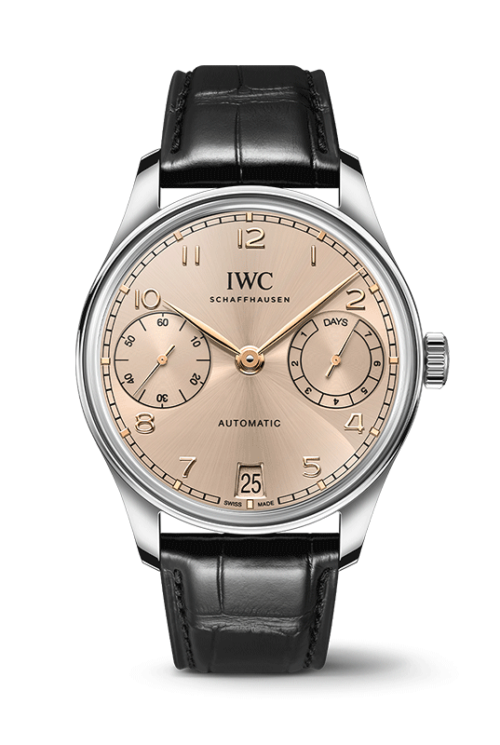IWC Shoots For Eternity At W&W 2024
Want to know how to become one of the most talked about participants at Watches & Wonders? Hint: ask IWC. The Schaffhausen-based watch manufacturer literally stole the show and took our collective breaths away with the unveiling of its mind-blowing Eternal Calendar. The first secular perpetual calendar from the brand, it will not require adjusting until the year 3999! Not to mention its hyper-precise moon phase display – you will have to keep reading to learn more about that marvel of mechanical ingenuity though. With a legacy steeped in precision engineering and timeless design, the IWC name is synonymous with exceptional craftsmanship and innovation. A well-earned reputation that has only been further strengthened by this year’s new releases. Read on to learn all about them.

The Year Of The Portugieser
As you may know already, IWC adopts somewhat of a different product launch strategy from many of its peers in the watchmaking world. Instead of debuting one or two new models across a range of collections, IWC largely focuses its attention on a single collection, introducing new models and reimagining and reengineering existing ones. In 2024, that collection is none other than the Portugieser.
Created in 1939 to fill a special order from two Portuguese importers for large wristwatches with high-precision pocket watch calibres, the Portugieser has evolved over the years into IWC’s best-selling collection. Yet every piece in the modern collection retains its connection to the original Ref 325 from all those years ago, thanks to that model’s distinctive aesthetic, informed in part by the popular Bauhaus modern art movement of the early 20th-century.
This school of design called for little ornamentation and a focus on balanced forms and abstract shapes. For IWC, this meant Arabic numerals for the hour markers, slim feuille hands and a “railroad track” chapter ring. Characteristics that are still found today on contemporary IWC Portugieser models. Over the years this dial layout, which promotes legibility without comprising on style, has been carefully evolved. Resulting in the modern Portugieser that is now known and loved the world over.
What’s New For 2024?

IWC Portugieser Eternal Calendar
The big announcement from IWC this year is of course the truly captivating IWC Portugieser Eternal Calendar. Presented in a 44.4mm platinum case – that alone should tell you this piece is something special – this is IWC’s first secular perpetual calendar. So, what does that mean exactly? Well, to answer that question, you first need to understand one of the key rules of the Gregorian calendar, which is the civil calendar in use today. It states that years evenly divisible by 4 are leap years, except for centurial years that are not evenly divisible by 400. So, in simple terms that means the years 1700, 1800, 1900, 2100, 2200 and 2300 are not leap years and thus your traditional perpetual calendar will require a manual adjustment in those years.
IWC’s Eternal Calendar meanwhile is mechanically programmed to consider these exceptions. This is made possible by a newly engineered 400-year gear, which completes just one revolution every four centuries, thus compelling the calendar to skip three leap years (2100, 2200, and 2300) over 400 years. As such, this groundbreaking mechanism promises accurate leap year calculations until at least the year 3999. (No official decision has been made yet as to whether the year 4000 will be a leap year.)
In many ways, this exceptional achievement has been decades in the making, all the way back to 1985, when IWC introduced the legendary perpetual calendar module developed by Kurt Klaus, marking the genesis of the brand’s mastery in mechanical calendars. Perhaps most impressively of all though is the fact that this secular perpetual calendar inherits the synchronized design of its predecessor, allowing all its displays to be adjusted via a single crown.

And let’s not forget about the hyper-precise moon phase we alluded to in the introduction, which has been meticulously developed by IWC’s engineers for unrivalled precision. After exhaustive calculations of over 22 trillion possible combinations, a reduction gear train with three intermediate wheels was devised. As a result, the Double MoonTM indication, featuring a titanium base disc and a rotating glass disc with two blue dots simultaneously showing the phases of the moon in both the northern and southern hemisphere, boasts a theoretical adjustment interval of 45 million years. Yes, you read that correctly. If the movement is kept running continuously, this moon phase display will theoretically only deviate from the Moon’s orbit by one day in 45 million years.

Somehow, IWC’s engineers have found a way to fit all this mechanical ingenuity into a round case that is barely 15mm thick and protected on both sides by double-domed sapphire crystals. The dial itself is also made of glass with a frosted and lacquered white underside. Following the domed contours of the box-glass crystal, the white lacquered minutes flange with its signature Portugieser railway track is also raised. The layout of the calendar functions on the dial remains true to those of Kurt Klaus’ original Perpetual Calendar design, with the calendar sub-dials also crafted in sapphire crystal, giving the impression they are floating above the glassy dial and creating an incredible sense of dimensionality. Completing the package is a black alligator leather strap from Italian shoemaker Santoni, with a platinum folding clasp.
At work inside the polished, brushed and elaborately finished platinum case is the IWC-manufactured 52640 caliber. The automatic Pellaton winding system uses revolutions of the rotor in both directions to build up a power reserve of 7 days (168 hours) in the two barrels.

IWC Portugieser Perpetual Calendar 44
Following hot on the heels of the Eternal Calendar comes a complete update of IWC’s iconic Portugieser Perpetual Calendar 44. After debuting in 2003, the Portugieser Perpetual Calendar has become a major pillar of the collection, making it one of the most sought-after models in the range. And with the new releases this year, IWC turns up the desirability factor even higher.
Presented in a fully reworked 44.4mm case, the new IWC Portugieser Perpetual Calendar is available in your choice of 18ct white gold or 18ct Armor Gold® (a variant of 5N gold that is significantly harder and more wear-resistant thanks to its sophisticated production process, during which the microstructure of the alloy is transformed). The case now features a slimmer middle band and a sleeker profile yet maintains a height of 14.9mm courtesy of the addition of double box-glass sapphire crystals (front and back) with antireflective coating on both sides.
As with the Eternal Calendar above, this serves not only to open-up the dial and create a further sense of depth but also results in a reduction in the overall weight of the piece without sacrificing its balanced proportions. And speaking of dials, the new ones on the Portugieser Perpetual Calendar are nothing short of spectacular. No less than fifteen layers of transparent lacquer are applied, before being fine-ground and then polished to a high gloss finish. The well-known sub-dials responsible for displaying the calendar information are milled into both the brass base and the lacquer layer. Finally, the appliques are individually mounted on the dials by hand. All of which comes together to give each of the coloured dials an incredible richness and sense of depth. Comprising up to 60 individual steps, the production process for the dials is incredibly complex and challenging to master.

Beneath the dial is the IWC 52616 calibre movement, comprising 385 individual parts. Incorporating IWC’s automatic Pellaton winding system, the components of which are made of virtually wear-free zirconium oxide ceramic, it reliably builds up a power reserve of 7 days in two barrels via the solid gold oscillating mass. The escapement has been improved to offer better protection against magnetic fields and it’s worth noting also that the water resistance of this reference has been increased to 50m (compared to 30m previously).
All versions feature IWC’s signature Double Moon™ display, which shows the moon as it can be seen from the Northern and Southern hemispheres. Thanks to a precisely calculated reduction gear, the indication will only deviate from the moon’s actual orbit by one day after 577.5 years. Each is paired with a matching leather strap from Santoni.

IWC Portugieser Chronograph
IWC’s classic chronograph also receives special attention this year, with the addition of new models in 18 Carat gold and stainless steel. The 18-carat 5N gold version boasts a richly dark Obsidian dial replete with gold-plated hands, and gold appliques. It’s paired with a matching black alligator leather strap for the ultimate in elegant refinement. The stainless steel option meanwhile captures the hue of the late afternoon sun with its Dune coloured dial and gold-plated hands appliques. It too is worn on a stylish black alligator leather strap. Like the Portugieser Perpetual Calendar, the dials feature fifteen layers of transparent lacquer that has then been polished to a high gloss finish.
The models are powered by the IWC-manufactured 69355 calibre, a robust mechanical chronograph movement in classic column-wheel design. The column-wheel control of the chronograph function ensures that individual phases in the switching sequence are clearly defined. There is also a distinct tactile resistance when the buttons are pushed. Expertly finished, the inner workings of the movement are visible through the sapphire display back.

IWC Portugieser Automatic
Also introduced at Watches & Wonders Geneva were new Portugieser Automatic 42 and Portugieser Automatic 40 models. Here again IWC has reworked the case construction, engineering a more slender side profile, making both case sizes visually lighter and more elegant. And in what is sure to be seen as a welcome move by collectors, both the Automatic 42 and Automatic 40 now feature double box-glass sapphire crystals, offering uninterrupted views of both the iconic dial lay-out as well as the IWC-manufactured movements inside.
Renowned for their balanced and highly legible display informed by Bauhaus principles, the dials of the Portugieser Automatic 42 & 40 are instantly recognisable. The larger version features twin sub-dials at 9 and 3 o’clock, displaying the running seconds and 7-day power reserve respectively, with the date shown via an aperture at 6 o’clock. The smaller version is an exercise in refinement, showing only the running seconds on a subsidiary dial at 6 o’clock.

As with the other models in the new Portugieser line up, the dials are the result of an elaborate and highly complex process. The brass bases are either treated with a sunburst finish or given a finely blasted surface before the colour is applied. Then comes the aforementioned fifteen layers of lacquer, which is fine-ground and then polished to a high gloss finish. The three-dimensional effect is further emphasised by the printing, which is carried out in a special procedure and adds to the sensation of depth. To finish, the appliques are individually hand mounted. A range of dial colours are available, including Obsidian black, Silver Moon and Blue, among others.

IWC Portugieser Hand Wound Tourbillon
Last but certainly not least comes the superbly understated Portugieser Hand Wound Toubillon, with a three-dimensional, globe-shaped day/night indicator visible from both the dial and movement side of the watch. Presented in a 42.4mm case hewn from polished and brushed 18-carat Armor Gold®, it is matched with the impossibly elegant Obsidian black dial that is a true standout of this new collection, complete with gold-plated hands, and gold appliques.
At six o’clock we find the flying minute tourbillon, one of the most sophisticated complications in watchmaking. Assembling and finetuning this delicate mechanism is a task reserved for the most experienced master watchmakers at IWC Schaffhausen. Completing a full rotation once every minute, the tourbillon houses the balance wheel and pallet lever inside a small cage, thus reducing the influence of gravity on the oscillating system of the watch and thereby increasing its accuracy. Incredibly, despite comprising 56 individual parts, the mechanism only weighs 0.675 grams in total. This is possible, in part, thanks to the construction of the pallet lever and escape wheel from lightweight silicon, which is then treated with a special diamond coating. This Diamond Shell® technology reduces friction and improves the flow of energy in the movement, contributing to the high power-reserve of 84 hours.

The other key drawcard is of course the 24-hour indicator in the shape of a small planet, which can be found at 9 o’clock. The globe has a dark and a bright side and rotates around its axis once every 24 hours, making it both intuitively easy to read but also visually quite captivating. The idea for this special day and night concept came from former watchmaker trainee Loris Spitzer and is a testament to the success of IWC’s trainee program and the culture of curiosity and innovation that the company fosters.
Behind the dial and visible through the sapphire glass display back is the newly developed IWC 81925 calibre. The gold-plated base plate of this hand-wound movement is partly skeletonised to offer views of the barrel and other components. As you would expect of a model of this pedigree, it is elaborately finished with circular Geneva stripes and is stunning to behold.
Available From Watches Of Switzerland
As a long-time Brand partner of IWC here in Australia, Watches of Switzerland is pleased to be able to offer our esteemed clientele a selection of the most alluring pieces revealed so far. Available throughout the latter part of this year, please contact us to arrange private viewings.

 Rolex
Rolex A. Lange & Söhne
A. Lange & Söhne Blancpain
Blancpain Breguet
Breguet Breitling
Breitling Cartier
Cartier Hublot
Hublot Vacheron Constantin
Vacheron Constantin IWC Schaffhausen
IWC Schaffhausen Jaeger-LeCoultre
Jaeger-LeCoultre OMEGA
OMEGA Panerai
Panerai Roger Dubuis
Roger Dubuis TAG Heuer
TAG Heuer Tudor
Tudor FOPE
FOPE Agresti
Agresti L’Épée 1839
L’Épée 1839







